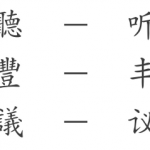Articles in the ‘Writing’ category Page 7
-
Drills and exercises aren’t only for beginners
It’s commonplace to see workbooks used a lot in beginner courses, but the more advanced the students become, the less they are used. This is mostly for the better, but in this article, I argue that advanced students actually need more drilling than they (we) think. Being able to say or write what we want in one way isn’t enough, we need diversity and a bigger active vocabulary. Drilling is the only time-efficient way of achieving that.
Read → -
Phonetic components, part 1: The key to 80% of all Chinese characters
At least 80% of all Chinese characters are made up of one semantic component (meaning) and one phonetic component (pronunciation). The sheer number of characters formed this way means that these characters ought to be taught properly, yet I think this topic is largely glossed over. This is the first article of two dealing with phonetic components and how they can help you learn Chinese better.
Read → -
Improving your Chinese by translating from another language
I think translation is one of the best ways of improving writing ability. Translation forces you into linguistic environments you wouldn’t have ended up in if you wrote the article yourself. This article is about how translation can be used to improve your written Chinese.
Read → -
Learning Chinese in the shower with me
This article is about using time and space in your shower to learn more Chinese. This might seem extreme, but it’s just another method of diversifying your learning. Why spend high quality time in front of your computer or in the library learning things you could equally well learn in your shower?
Read → -
Kickstart your Chinese character learning with the 100 most common radicals
This is a list of the 100 most common radicals among the 2000 most common characters, meaning that it’s excellent for beginners who want to boost their understanding of Chinese characters. The list contains simplified, traditional, variants, meaning, pronunciation, examples, helpful comments and colloquial names.
Read → -
Language is communication, not only an abstract subject to study
I won’t join the group of language bloggers who claim that classroom learning is meaningless, but I do believe there are good reasons to create links to the real world. Not only is this a motivational booster, it’s also an excellent way of identifying problems you might have with your Chinese.
Read → -
Using Lang-8 to improve your Chinese
Learning a foreign language, most people lack proper feedback from native speakers. Even if we have friends and teachers, always having to ask for help isn’t very good. In this article, I explain how Lang-8 solves this problem for you. Useful for any language, not just Chinese!
Read → -
When perfectionism becomes an obstacle to progress
Perfectionism is usually regarded as something positive, perhaps even necessary. Scoring 100% on an exam is good, isn’t it? No, it’s not. In this article, I explain why perfectionism is bad when learning a language. Aiming for 90% is far better than aiming for 100%. This is being smart, not lazy.
Read → -
Making progress in Chinese in spite of praise
Praise is a double-edged sword. On the one hand, it’s encouraging and makes it more rewarding to study. On the other hand, however, if you use other people’s praise as a true indication of your own ability, you’re in deep trouble. Feel encouraged, but it’s essential that you don’t trust native speakers when they tell you your Chinese is great!
Read → -
Learning simplified and traditional Chinese
Learning traditional characters if you know simplified or vice versa is a lot easier than beginners tend to think. Generally, you don’t need to worry, because at an advanced level, learning both is quite easy. This article is about simplified/traditional and how to learn both.
Read →








